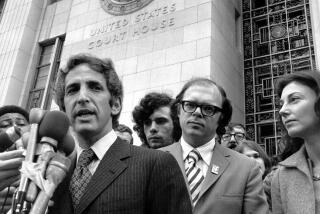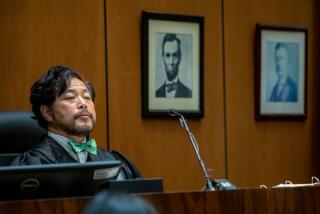DEA: Agent’s Role in Drug Smuggling Case Investigated
Seven months after “evidentiary problems” forced federal prosecutors in San Diego to retreat from charges against a convicted drug smuggler and her alleged accomplice, the Justice Department is investigating the conduct of a Drug Enforcement Administration agent who defense lawyers and a handwriting expert say falsified the critical piece of evidence in the case.
Justice Department spokesman John Russell confirmed last week that the investigation concerning DEA Special Agent Robert Martinez is under way. One of the defense attorneys in the marijuana-smuggling case, Frank Murphy of San Diego, said he had recently been interviewed by an attorney with the department’s public integrity section in Washington.
The dismissal of smuggling and conspiracy charges against Helen Irmgard Bristol a month after her conviction by a federal jury last fall was an extraordinary step by government prosecutors, according to area attorneys and judges. Similar charges against her boyfriend, Dwight M. Bryant, whose case was about to go to trial, also were dropped.
The Bell Gardens couple, both 29, were accused of smuggling 145 1/2 pounds of marijuana, hidden in a friend’s van, into the United States at the Calexico border crossing in May, 1986.
A crucial element in the case--evidence central to prosecution arguments in Bristol’s trial and key to the setting of Bristol and Bryant’s defense strategies--was a scribbled computation on a letter to Bryant. The envelope, found in the glove box of a station wagon Bryant drove behind the van, seemingly indicated the dollar value of the drugs.
Suspicion Aroused
Bryant insisted that the handwriting on the envelope was not his, however. And after reviewing other documents in the case, Murphy, his lawyer, suspected that the writing was Martinez’s. After handwriting samples were taken from the drug agent, a defense expert concluded that the calculation was made in Martinez’s hand.
Rather than reveal its own expert’s conclusions, the government asked U.S. District Judge John S. Rhoades on Oct. 21 to dismiss the felony charges against Bryant “in the interest of justice,” according to court filings. On Oct. 24, a month after Bristol’s conviction, Assistant U.S. Atty. Marian McGuire asked U.S. District Judge Earl B. Gilliam to drop the charges against her as well, “in the interest of justice due to evidentiary problems with the government’s case.”
Prosecutors have never offered any further explanation of the dismissals. Martinez remains a DEA agent on active duty, but he has left Calexico. And though defense lawyers are pleased that Martinez’s conduct now is under investigation, they say the incident--and the government’s handling of it--were outrageous.
“They just wanted to back-door it, hush-hush, and get rid of this thing,” said Larry Ainbinder, the federal public defender who represented Bristol.
Murphy said the government has moved “awfully slowly” to investigate the incident, given the seriousness of the allegations.
“If you can’t trust the evidence because somebody has manipulated it, you’ve really cut at the core of the entire system,” he said. “If it’s OK for the guy to falsify the handwriting, it’s OK to do just about anything. He could plant drugs, plant weapons, just plain frame people. I don’t think it can be tolerated.”
The DEA will not disclose Martinez’s new posting, and he could not be reached for comment. McGuire and DEA officials in Calexico and San Diego declined to discuss the case.
Envelope Surfaces
The envelope first surfaced in August after, Murphy says, he had poked significant holes in the government’s case against Bryant during a pretrial hearing. Recognizing its importance as evidence against his client, Murphy drove to the DEA’s office in Calexico to look at the document and discuss it with Martinez.
The agent told him the document had been found among the papers in the station wagon when the vehicle was seized but that he had not noticed the handwritten computation until a few months later, when he was preparing photocopies of the government’s evidence to turn over to the defense, Murphy recalled.
Murphy was dubious. Even if his client had knowingly driven the marijuana across the border, so-called “mules” normally don’t keep records of their shipments, he knew. Smugglers moving drugs out of Mexico, moreover, talk in terms of kilograms, not pounds, so Murphy said he would have been surprised if a smuggler would have calculated the value of his cache in pounds.
And there was Bryant’s insistence that he had not written the figures on the envelope.
“He was just adamant all the way through in denying he wrote those numbers on there,” Murphy said.
The clincher, for Murphy, came as he studied other documents prepared by Martinez--documents that happened to include letters and numbers written in Martinez’s hand.
“I just happened to be fumbling through the file, wondering how am I going to explain this to the jury, and I noticed the way he hooked his fives,” Murphy said. The digits, he explained, looked just like those on the incriminating envelope.
Meanwhile, Bristol’s case went to trial before Gilliam. She, too, denied having written the computation on the envelope. Ainbinder’s strategy was to attribute it to Bryant. “This particular piece of evidence was just devastating,” Ainbinder said.
Focus of Argument
Martinez testified about the document--as he had at an earlier hearing--and McGuire, the prosecutor, made its existence a focus of her successful argument for Bristol’s conviction. On Sept. 22, the jury found the woman, a West German native living in the United States as a resident alien, guilty on six felony counts of smuggling and conspiracy.
By then, Murphy’s doubts about the document were sufficiently firm that he asked McGuire for samples of Martinez’s handwriting. McGuire, he said, countered with a request for samples of Bryant’s handwriting. They agreed that the agent, Bryant, the two lawyers and their respective handwriting experts would meet at McGuire’s office.
The exercise, Murphy said, was conducted by Dave Oleksow, a San Diego Police Department documents examiner. Martinez and Bryant wrote out lists of letters and numbers. Then, without showing them the disputed envelope, Oleksow asked them to write out the calculation at issue: 145 x 500 = 72,500.
Bryant wrote the figures step by step, first multiplying out two lines of zeroes, then multiplying by five, and finally adding the lines together to come up with the total.
Martinez, though, virtually duplicated the scribbled computation on the envelope. He lined up the “500” under the last digit of “145,” did the multiplying in one step, noted the carry-over figures and wrote down the total.
Murphy and the defense expert, former San Diego police crime laboratory director Elmer Wadman, said the results were indisputable.
“It proved the defendant had not put those figures on the paper, but rather the investigator had,” said Wadman, a retired police lieutenant. “It was open and shut.”
Declined to Comment
Oleksow did not announce his conclusions at the meeting. Instead, a few days before Bryant’s scheduled trial, the government asked the court to drop the charges against him and Bristol.
“Though no one ever came out and said it, the government expert also concluded this was Bob Martinez’s handwriting,” Ainbinder said. “It was pretty obvious what their expert’s conclusion was.”
Oleksow declined last week to comment on the case.
The nature and extent of the ongoing government investigation are unclear. Russell, the Justice Department spokesman, said only that the Martinez inquiry was “an open matter.” Murphy, who said he met with Justice Department attorney Fred Jones III in late April, said Jones “seemed to be interested in investigating the matter” and appeared to be “in the evidence-collecting stage.”
Through a spokesman, Jones declined to comment.
Defense attorneys were critical of the government’s handling of the case, saying it was an example of what they consider the predilection of prosecutors for keeping silent about circumstances that could prove embarrassing to law enforcement.
“There should have been an airing of the misconduct, and then positive, affirmative steps--sanctioning action--taken against the law enforcement agent,” said defense attorney John Cleary, a former executive director of San Diego’s federal public defender office. “But it never happens.”
Instead, in the occasional instances when law enforcement misconduct is alleged, as in the Bristol-Bryant case, it is more common for prosecutors simply to drop the charges against the defendant, rather than risk humiliating a law enforcement agency in court, he said.
“There’s a kind of rule,” Cleary said. “The defendant’s got no squawk if he gets a walk.”
James W. Brannigan Jr., chief of the criminal division of the U.S. attorney’s office in San Diego, said prosecutors do not overlook misconduct simply because the wrongdoer is a law enforcement agent.
“If there is an action by anybody--law enforcement officer or not--which is within our realm of prosecution, and it’s a prosecutable case, then we will prosecute it,” he said. “That’s the way I’ve always viewed it and that’s the way we do it.”
More to Read
Sign up for Essential California
The most important California stories and recommendations in your inbox every morning.
You may occasionally receive promotional content from the Los Angeles Times.










